Countdown to EAA, T-367 Days (W)
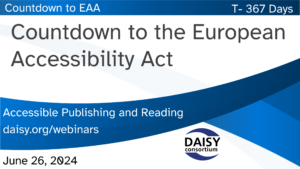
In our new series of EAA monthly webinars, June 26th saw an overview session of the European Accessibility Act, kick starting the DAISY Countdown series of webinar events in the run up to the EAA coming into force in June 2025. Beginning with an interview with George Kerscher, this event also gave an introduction to the EAA itself, exploring the implications for people involved in publishing and reading, and talking to industry professionals actively working to prepare their organizations and others.
This page contains:
Full Video of the Webinar
Speakers
- Richard Orme, The DAISY Consortium—host and chair
- George Kerscher, The DAISY Consortium
- Inmaculda Plancencia Porrero, The European Commission
- Elin Ljungvall, Hegas
- Hans Beerens, Dedicon
- Christina Mussinelli, The LIA Foundation
Session Overview
This introductory webinar was hosted by DAISY’s Richard Orme who welcomed the large audience and DAISY colleague George Kerscher as the “leading thinker and doer” in accessible digital publishing.
Interview with George Kerscher
George gave us a snapshot of his experience as a university student where access to content was impossible for him. This spurred him on to form his first company “Books for the Blind and Print Disabled” which was hugely successful and Richard Orme remembers RNIB receiving disks from the various mailings that George organized. Fast forward to 2001 when George’s Dream speech at the DAISY technical conference was very well received and encouraged the publishing community to start taking accessibility seriously.
Overview of the European Accessibility Act
Inmaculda Plancencia Porrero from The European Commission gave us a high level glance at the EAA and what we can expect from it. Considering issues such as:
- What is covered in the EAA?
- What products are in scope?
- Requirements and provisions for products and services
- What is an ebook?
- Enforcements and penalties
- Ebook related annexes
this was a whistle-stop tour of the major areas for consideration
Some Industry Perspectives
Our remaining 3 speakers spoke about their enthusiasm for the EAA and what still needs to be done. Elin Ljungvall hopes to have clear guidelines to enable her organization to provide the right books to the right child in the right format. Hans Beerens is excited about the prospect of greater accessibility for all and Cristina Mussinelli is looking forward to helping all readers to read and fostering inclusivity. Awareness building, training and skill development were areas that still need attention this year.
A Recent Survey
Richard presented some initial findings resulting from a survey conducted to help us point to relevant topics and resources within this webinar series. There are concerns from all areas about readiness for 2025 and our initial findings did reveal that many governments have set up departments to facilitate this. In the publishing community we’ve seen a lot of mainstream tool support but organization’s reliance of established processes could hinder progress for take up of these various tools. The survey remains open and we encourage continuing feedback as we get closer to the EAA.
Related Resources
- Full transcript Word document
- Link to the survey
- EAA resources page
- European Accessibility Act
- The Soundproof Book article published 2002
Related past webinars:
- The European Accessibility Act—Consideration for the Publishing Industry and Benefits to Consumers Globally (W)
- EU Accessibility Act: Update (W)
- DAISY treasure trove of webinars
Guest presenter links:
- Elin Ljungvall | LinkedIn
- Hegas
- Hans Beerens | LinkedIn
- Dedicon
- Cristina Mussinelli | LinkedIn
- LIA Foundation
Discover the other webinars we’re running! This event was just the beginning – be sure to sign up for the next 3 webinars on the backlist, accessibility testing and image description.



 In our series of
In our series of  In our series of
In our series of 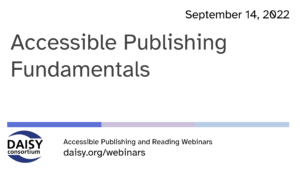 September 14th 2022 saw the first in a new season of
September 14th 2022 saw the first in a new season of 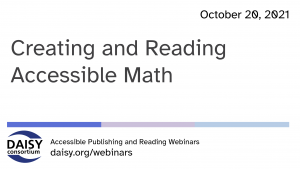 In our series of
In our series of 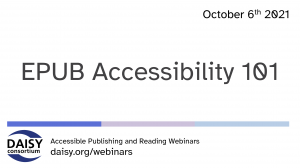 In our series of
In our series of 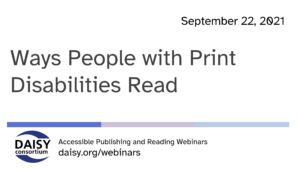
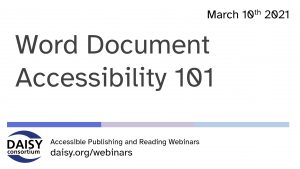 In our series of
In our series of